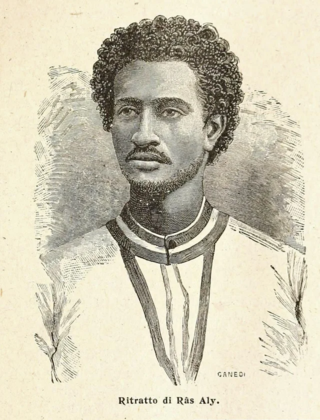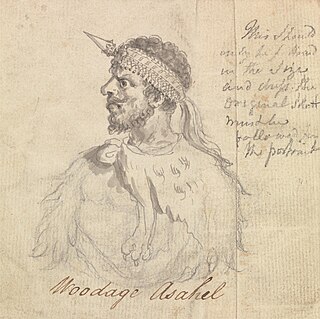Related Research Articles

Tewodros II was Emperor of Ethiopia from 1855 until his death in 1868. His rule is often placed as the beginning of modern Ethiopia and brought an end to the decentralized Zemene Mesafint.
Yohannes III was Emperor of Ethiopia intermittently between 1840 and 1851, and a member of Solomonic dynasty. He was the son of Tekle Giyorgis. He was largely a figurehead, with real power in the hands of the Enderase or Regent, Ras Ali II a princeling of the Yejju Dynasty. Ras Ali's mother was the Empress Menen Liben Amede.

Tekle Giyorgis II was Emperor of Ethiopia from 1868 to 1871. After being crowned, he linked himself to the last independent emperors of the Gondar line through his mother and sought support from the Ethiopian Church to strengthen his right to rule. He was wounded when fighting during the 1871 Battle of Adwa, leading to the demoralization of his troops and capture of him and his generals and later on his death in captivity.
Sahle Dengel was Emperor of Ethiopia intermittently between 1832 and 11 February 1855, towards the end of the Zemene Mesafint. He was largely a figurehead, with real power in the hands of Ras Ali II of Yejju.

Debre Tabor is a town and woreda in northern Ethiopia. Located in the Debub Gondar Zone of the Amhara Region, about 100 kilometers southeast of Gondar and 50 kilometers east of Lake Tana, this historic town has a latitude and longitude of 11°51′N38°1′E with an elevation of 2,706 metres (8,878 ft) above sea level. The presence of at least 48 springs in the area contributed to the development of Debre Tabor.
Marye of Yejju was a Ras of Begemder and Enderase (regent) of the Emperor of Ethiopia. He was the brother of his predecessor Ras Yimam.
Yimam of Yejju was a Ras of Begemder and Enderase (regent) of the Emperor of Ethiopia. He was the son of Gugsa of Yejju.

Ali II of Yejju was Ras of Begemder and the de facto ruler of the Ethiopian Empire. He was a member of a powerful Welo dynasty known as the Yejju, which ruled much of the Ethiopian Empire during the Zemene Mesafint.
Alula of Yejju was the son of Ras Ali I of Yejju and cousin of Ras Gugsa. He was the first husband of Menen Liben Amede and father of her son, Ras Ali II, while governor of Damot, Ethiopia.

Until the end of the Ethiopian monarchy in 1974, there were two categories of nobility in Ethiopia and Eritrea. The Mesafint, the hereditary royal nobility, formed the upper echelon of the ruling class. The Mekwanint were the appointed nobles, often of humble birth, who formed the bulk of the aristocracy. Until the 20th century, the most powerful people at court were generally members of the Mekwanint appointed by the monarch, while regionally, the Mesafint enjoyed greater influence and power. Emperor Haile Selassie greatly curtailed the power of the Mesafint to the benefit of the Mekwanint, who by then were essentially coterminous with the Ethiopian government.
The Battle of Gur Amba was fought on 27 November 1852 between the forces of the Ethiopian regent, Ras Ali II, and the rebel forces of Kassa Hailu. Kassa was victorious, and Goshu Zewde of Mota, Gojjam, the commander of the regent's forces, was killed. This was the first of a series of four victories which led to Kassa becoming Emperor Tewodros II of Ethiopia.
The Battle of Amba Jebelli was fought in Ethiopia in 1854 between the forces of Kassa Hailu, and the forces of Birru Goshu of Gojjam. Kassa was victorious, Birru Goshu was captured and spent the next 14 years in chains.
The Battle of Ayshal was fought on 29 June 1853, between the forces of Kassa Hailu and the forces of Ras Ali II, in Ayshal, in eastern Gojjam. Kassa's forces won the battle.

The Zemene Mesafint was a period in Ethiopian history between the mid-18th and mid-19th centuries when the country was ruled by a class of Oromo elite noblemen who replaced Habesha nobility in their courts, making the emperor merely a figurehead. For the most part, the regional lords were tightly related by marriage and constituted a stable ruling elite that prevailed until the mid-20th century. In short, during the Zemene Mesafint, the emperors from the Solomonic dynasty were reduced to little more than figureheads confined to the capital city of Gondar.
Tewabech Ali was the first wife of Kassa Haile, better known as Emperor Tewodros II of Ethiopia. They were married in 1848.

The Yejju Oromo, also historically known as the Yajju, Edjow or Edjou Galla, are a sub-clan of the Barento branch of Oromo people. They are one of the northernmost communities of Oromo people residing in Ethiopia, along with the Raayyaa.
Dejazmach Birru Aligaz was a nobleman of 19th century Ethiopia during the Zemene Mesafint. As Dejazmach, he held the governorships of different districts such as Lasta and Dembiya and was made governor of Dawunt, Wollo in 1842 by Ras Ali II of Yejju. He was the son of Ras Aligaz Abba Seru Gwangul, and had a son called Dejazmach Zegeye.

Wube Haile Maryam of Semien,, also called by his title Dejazmach Wube, Webé; his name is also given in European sources as ‘‘Ubie’’, was one of the major figures of 19th century Ethiopia, during the closing decades of the Zemene Mesafint a period of regional lords vying for power, prestige and territory amid a weakened authority of the emperors.
Betul Haile Maryam was a member of the Semien nobility through his paternal line in the Ethiopian Empire.

This article is about the history of Gondar, a city in Amhara Region of Ethiopia, and previously served as the capital of the Ethiopian Empire from 1632 (at the beginning of Gondarine period to 1855 era.
References
- ↑ Mordechai Abir, Ethiopia: The Era of the Princes (London: Longmans, 1968), p. 38
- ↑ Sven Rubenson, King of Kings: Tewodros of Ethiopia (Addis Ababa: Haile Selassie I University, 1966), p. 22
- ↑ Richard P.K. Pankhurst, History of Ethiopian Towns (Wiesbaden: Franz Steiner Verlag, 1982), pp. 271ff.
- ↑ H. Weld Blundell, The Royal chronicle of Abyssinia, 1769-1840 (Cambridge: University Press, 1922), p. 491f
- ↑ Abir, Ethiopia: The Era of the princes, p. 128f
- ↑ Rubenson, King of Kings: Tewodros of Ethiopia, p. 44
- ↑ Rubenson, King of Kings: Tewodros of Ethiopia, pp. 36-39